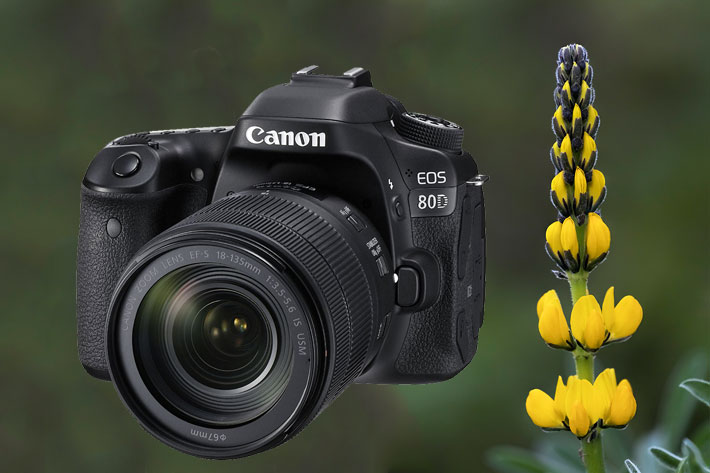
I had the opportunity to try a Canon EOS 80D for three days, but rain and bad weather made it difficult to use it for what I wanted: video of surfers riding waves and flowers in the fields. Still, I got to photograph the first lupine flowers of this Spring, at the end of a cloudy day with little available light. The results are very promising.
For flower photography I usually work with wide apertures, to keep backgrounds out-of-focus, so speed is not usually a concern, although my focal length of choice for flowers is usually around 400mm, lately on the new lens launched last year, the impressive EF 100-400mm f/4.5-5.6 L IS II USM. I want to use the EOS80D paired with that lens for video as well, but that experience will have to wait a little longer. For now I managed to photograph a few lupine flowers (from which we mostly get the yellow variety over here), from which I picked three photos to show the potential of the new camera.
My photographs of flowers are always created with backgrounds and foregrounds out-of-focus, so as to center attention on the main subject. With the EF 100-40mm, which can focus at around 3.2 feet (+/-98cm), half of what the previous model of the lens could achieve, I can leave my macro lens at home, most of the time, as the close-up results I get with most flowers are fantastic. At 400mm, with an aperture of f/8, I get a sharp flower and a soft background.
No tripod used
I mostly work handheld, meaning I need to use a fast enough shutter speed so images are sharp. Even if the IS (Image Stabilizer) system helps, I rather not depend on it much for my photographs of flowers. So I need to use a shutter speed around the reciprocal of the focal length. This means I’ve some limitations when it comes to my flower photography, especially as I do not want to use high ISO values, as it introduces noise. I tend to not go above 400 ISO, and this with good light, because with good light you usually don’t get into – much – trouble when it comes to noise. In fact, noise mostly appears in shadow areas underexposed.
Sometimes, though, I need to open the aperture to f/5.6, especially when the light is low, and that’s what I did while using the EOS 80D. The light at the end of the day did not help much to get the lupine flowers properly exposed, the first found in a place I scout regularly for new flowers at this time of the year. I wanted to get the photos, and I did, in a few minutes, before all light was gone. To do so I decided to raise the sensitivity of the sensor to 800 ISO, which gave me an exposure of 1/320 at f/5.6, just about enough to get a proper and sharp exposure with a handheld 100-400mm lens.
Some people may argue that 800 ISO is not a high ISO by today’s standards, but for me 800 ISO is a lot, as I come from transparency film, which I used for years for editorial and commercial work. Fujifilm’s Velvia at 50 ISO and Kodak Ektachrome’s at 64 and 100 ISO were my references, so anything above 100 ISO was already too much. It’s with this background that I transitioned to digital, in 2000, meaning that I always try to use the lowest ISO I can – especially for flowers and other delicate subjects – even today. So 800 ISO images on the EOS 80D is a new experience.
The resulting images, with RAWs edited first in Canon’s DPP software and then the JPEGs finished in Photoshop, with a touch of Topaz Labs, show what can be achieved with the new sensor, and point me in a new direction of exploration: higher ISO. When I‘ve the chance to try the EOS 80D for a few more days I want to explore how far I can go in terms of sensitivity when photographing flowers. I am quite pleased with the results from the few photographs of flowers I was able to make.
Video is next
I’ve tested some of the video aspects of the camera with other subjects, but I also want to explore the camera further with flowers and out-of-focus backgrounds and foregrounds, using NDs to achieve similar results. I’ve tried it before with other DSLRs, but the focusing system of the EOS 80D, coupled with the touch sensitive LCD, similar to the one of the EOS 70D, makes it easier. Still, that has to wait for better days and more Spring flowers in the fields.
Something else I did not have time to do yet is to use the EOS 80D with flashes for another technique of photographing flowers, using the protocol from Meet Your Neighbours, a worldwide photographic initiative dedicated to reconnecting people with the wildlife on their own doorsteps – and enriching their lives in the process. The photo above is an example of the results achieved – with an old EOS 50D – using two flashes and a sheet of white acrylic in the field studio, as all plants and animals are photographed in the wild. In this case I am not after the high ISOs usable with the EOS 80D but a new Picture Style introduced with the EOS 5Ds, Fine Detail, also available here, which works a bit like having an adjustable Unsharp Mask inside the camera. From the few examples I shot, it offers interesting results that I want to explore further, both for photography and video, especially with flowers.
To see the images published here in a bigger size check the note I wrote at Medium, Photographing lupine flowers with the Canon EOS 80D DSLR.
As for the Canon EOS 80D, it will be present at Canon’s booth at NAB 2016, as a video-centric DSLR.
